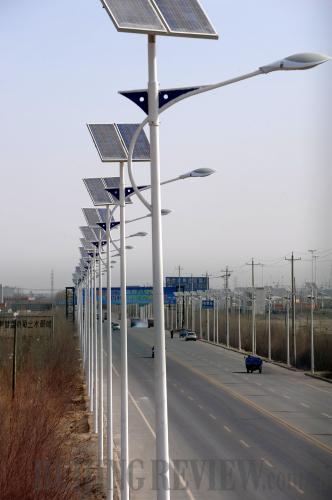|
 |
|
MODERN CITY: The solar-powered street lamps in Golmud, northwest China's Qinghai Province, are a sign of the fast development of the transportation hub on Qinghai-Tibet highway and railway (JUE GUO) |
Back From Expedition
China's 27th Antarctic expedition arrived in Shanghai on April 1, wrapping up a 142-day expedition to ice-covered Antarctic.
Researchers completed 31 scientific research missions, 25 logistical assignments and an international collaborative project while dealing with the continent's harsh weather conditions.
Seismic observation, ozone monitoring and studies of Antarctic land formations were among the scientific missions conducted there.
The 190-member research team began its expedition on November 11, 2010, when they set out from the southern Chinese city of Shenzhen.
Flood Prevention
The State Council approved on April 6 an overall plan to further harness China's small and medium-sized rivers and reinforce dilapidated reservoirs to prevent large, flood-triggered geological disasters.
Over the next five years, China will address prominent problems in more than 5,000 small and medium-sized rivers with a minimum drainage area of 200 square km each, 300 large and medium-sized dilapidated reservoirs as well as 20,000 small ones.
Measures will also be taken to improve the conditions of more than 2,000 large and medium-sized dilapidated water gates as well as the conditions of protective embankments and flood storage and retention areas in Dongting and Poyang lakes in the south.
Road Safety
China kicked off a three-month road safety campaign on April 1, following a spate of deadly accidents in March.
Police authorities will set up temporary checkpoints along highways and expressways to monitor hazardous moves such as overloading, says a statement issued by the Ministry of Public Security.
Companies operating long-distance coaches, city buses and tourist vehicles that are found to have safety risks will have to suspend business until the risks are eliminated or their licenses will be revoked, says the statement.
Four fatal road accidents occurred from March 11 to 16, killing 66 people and injuring 87 others respectively in Xinjiang Uygur Autonomous Region, Tibet Autonomous Region, and Shanxi and Jilin provinces.
Projects in Xinjiang
Xinjiang Uygur Autonomous Region in northwest China started construction of 17 reservoirs and a water diversion project on April 2.
The projects will cost 1.44 billion yuan ($220 million) and have a total storage capacity of more than 95 million cubic meters. They are expected to help more than 17,000 nomadic households settle down by increasing and improving 107,000 hectares of irrigated areas after their completion in the winter of 2012.
Xinjiang has nearly 1.23 million herdsmen, 60 percent of whom move from place to place due to difficult living conditions. The improvement in water supply would enable nomads to engage in animal husbandry and farming to increase their income, said a spokesman with Xinjiang's water resources department.
Space Mission
China's second lunar orbiter Chang'e-2 has achieved all goals and will carry out further research operations, said the State Administration of Science, Technology and Industry for National Defense on April 1.
According to a statement of the administration, operations of Chang'e-2 remained normal after 180 days in space.
The solar-powered probe was launched on October 1, 2010, to collect information for a moon-landing. It entered its long-term lunar orbit on November 3 and has collected a great amount of scientific data. | 